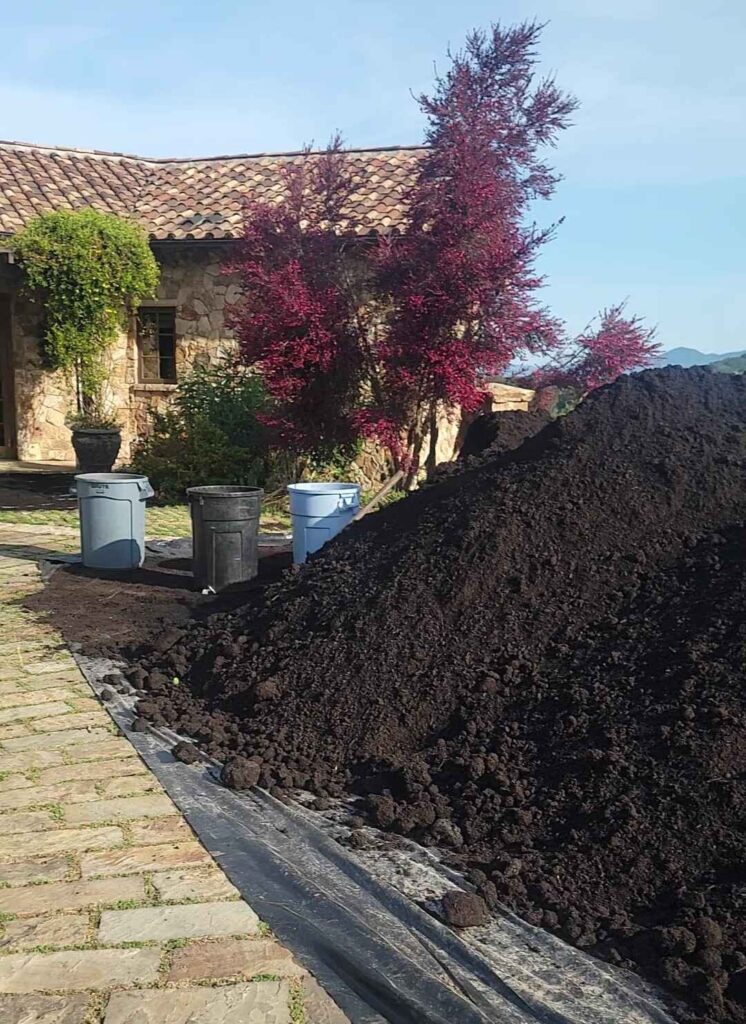
Transform Your Garden: Expert Design Tips to Get Ready for Spring
Being ahead of the seasons is the number one way to ensure you have a thriving garden year round, as we enter the end of fall we are reaching one of the most critical times of year to take action in the garden. It might not seem that way as most plants are going into dormancy and the garden looks less lively than ever, however bountiful blooms and vibrant growth occur only when the stage is properly set in the seasons before. Here are five expert tips from professional landscaper designers, to be sure you’re well positioned to roll into spring happy as the bees in the flowers.
 Add Mulch to Your Planting Beds
Add Mulch to Your Planting Beds
Knowing how to prepare your garden for spring is one of the most important questions for new landscape care, and the first step is mulch! Mulching can mean many different things from adding bark, compost, rock, or other type of material to cover the soil. However adding compost mulch before the winter rains is by far the best action you can take to rejuvenate your landscape. Compost mulch is rich in organic matter and full of beneficial fungi and bacteria that create a healthy soil food-web which is the hallmark of a thriving garden.
Building Dynamic Soil
We always say, “Feed the soil, not the plants” and by that we mean that building a healthy dynamic soil rather than adding specific minerals through fertilizers, you are caring for your plants in the most effective way. With a healthy soil your plants will have greater resilience to heat, drought, pests, diseases, as well as being able to uptake the nutrients within the soil. Oftentimes all the minerals are already in place, adding more just stresses the plants out, feeding the soil with compost opens up their ability to search for and receive the minerals they need to thrive, not to mention compost usually contains all the minerals your plants need in a balanced form.
Composting
Additionally compost will break up compacted soils, allowing roots to penetrate deeper allowing for more foliar growth, thicker stems, more bountiful flowers, and larger harvests of fruit and vegetables. Applying a 2” layer of compost to your beds will be plenty, and in turn, you’re sequestering carbon into the ground. Bonus points if you source your compost from a local processing facility, a great way to incorporate sustainability into your landscape design. This option creates a closed loop of green waste in your community by preventing green waste from going to a landfill where it turns into methane gas adding to our ever growing issues with climate change.
Supporting Local
As a regenerative company, Inspired Landscapes sources all of its compost from local facilities to reduce trucking as well as incentivize local resource recovery companies to create compost rather than send green waste to landfills.
 Divide Your Perennials
Divide Your Perennials
Over time most perennials grow beyond their capacity to thrive and end up suffocating themselves resulting in smaller and shorter blooms. By dividing perennials you encourage them to continue expanding, pushing new growth, and as a result blooming more prolifically. Dividing perennials is as simple as chopping off portions of the plant when it is dormant and either planting the chopped off portion in a new section of your garden, giving it to friends for their garden, or composting for your plants and the planet. Get creative and use these ‘free’ plants to evolve your existing garden design and expand existing patterns within your planting layout.
Prune Your Plants
While this might seem like a maintenance task, pruning can be quite creative as how you prune directly impacts how a plant will grow when spring comes. For example by reducing the amount of canes on a rose bush to 5-9 main thick canes (larger than the size of a pencil) you will create a rose bush with large fragrant blooms, rather than one with small tepid blooms that dry out quickly. Removing thin spindly canes gives the plant its instructions to focus all of its energy on the remaining main thick canes which means each flower gets super charged.
Plant Shaping
Shaping plants for the coming year also impacts their aesthetics. For example you can cut back lanky shoots and form an Olive tree into a beautiful oval, or thin out interior branches to encourage large spurts of growth on the fringes of the canopy. Shrubs can be shaped into formal patterns, or have their branches thinned to encourage a natural flowing form. Each of these pruning methods results in a completely different response from your plants, so get playful and try different ideas out to see what works best for you and explore different expressions of the same plant!
 Start Seedlings and Take Cuttings
Start Seedlings and Take Cuttings
Propagating your own plants for the spring is a fantastic and cost effective way to have many different colors and textures in your planting palette as well as a fun way to attract butterflies and hummingbirds to your garden. As soil temperatures rise and you choose which areas to fill in and which areas you might want to try something new. It can be discouraging to go to a plant nursery and spend a lot of money on new plants that don’t succeed in the garden and this results in many people ‘playing it safe’ with tried and true familiar plants.
Try Your Seeds
Yet from a design perspective this can end up being quite boring, by trying out a bunch of different seeds you embark on a low risk approach to diversity in the garden, which is a hallmark of ecological health. If some plants don’t make it, no sweat, seeds only costs a few cents. You can therefore try out all sorts of different ideas to see what you like most and what does best in your garden, often you’ll be surprised by plants that a book tells you isn’t going to do well and for some reason it thrives. When you’re only buying established plants this could be a costly and disappointing endeavor.
Propagating Your Plants
Taking cuttings is a slightly more advanced way to propagate plants, however if you see a plant in a friend or neighbor’s garden, you could take a cutting and root it on your own. Always make sure to ask permission before taking cuttings! Some plants propagate very easily such as those in the lamiaceae (mint) family, for example Salvia and Agastache are very easy to propagate. Cuttings from most succulents will root directly into the ground or a pot without much fuss, the same goes for Roses. This is a wonderful way to try out a variety of new plants in your garden without the risk of losing money on buying plants from a nursery.
Spring into Action with Inspired Landscapes!
Ready to get started? At Inspired Landscapes, our landscapers near you specialize in bringing your vision to life with sustainable practices and expert guidance. Let us help you create the garden of your dreams. Contact us today or give us a call at (707) 395-7474 to schedule a consultation and take the first step toward a stunning spring transformation!

Owner, Inspired Landscapes LLC
Matthew Ripley is the owner of Inspired Landscapes LLC, a Healdsburg based landscape design, installation, maintenance, and irrigation firm serving Sonoma County. His work blends horticultural expertise with sustainable practices, drawing creative influence from Sierra backpacking and Sonoma winery estates to craft gardens that invite wildlife and year round color. Client testimonials highlight his design leadership on residential, estate, and winery properties across the region.





